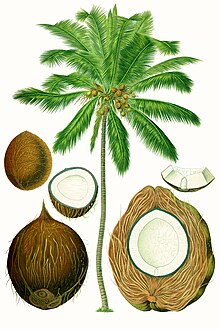Coconut tree
| Coconut Temporal range: 55–0 Ma Early Eocene – Recent |
|
|---|---|
 |
|
| Coconut palm (Cocos nucifera) | |
| Scientific classification | |
| Kingdom: | Plantae |
| (unranked): | Angiosperms |
| (unranked): | Monocots |
| (unranked): | Commelinids |
| Order: | Arecales |
| Family: | Arecaceae |
| Subfamily: | Arecoideae |
| Tribe: | Cocoeae |
| Genus: | Cocos |
| Species: | C. nucifera |
| Binomial name | |
|
Cocos nucifera L. |
|
| Nutritional value per 100 g (3.5 oz) | |
|---|---|
| Energy | 354 kcal (1,480 kJ) |
|
15.23 g
|
|
| Sugars | 6.23 g |
| Dietary fiber | 9.0 g |
|
33.49 g
|
|
| Saturated | 29.698 g |
| Monounsaturated | 1.425 g |
| Polyunsaturated | 0.366 g |
|
3.33 g
|
|
| Tryptophan | 0.039 g |
| Threonine | 0.121 g |
| Isoleucine | 0.131 g |
| Leucine | 0.247 g |
| Lysine | 0.147 g |
| Methionine | 0.062 g |
| Cystine | 0.066 g |
| Phenylalanine | 0.169 g |
| Tyrosine | 0.103 g |
| Valine | 0.202 g |
| Arginine | 0.546 g |
| Histidine | 0.077 g |
| Alanine | 0.170 g |
| Aspartic acid | 0.325 g |
| Glutamic acid | 0.761 g |
| Glycine | 0.158 g |
| Proline | 0.138 g |
| Serine | 0.172 g |
| Vitamins | |
| Thiamine (B1) |
(6%)
0.066 mg |
| Riboflavin (B2) |
(2%)
0.020 mg |
| Niacin (B3) |
(4%)
0.540 mg |
| Pantothenic acid (B5) |
(6%)
0.300 mg |
| Vitamin B6 |
(4%)
0.054 mg |
| Folate (B9) |
(7%)
26 μg |
| Vitamin C |
(4%)
3.3 mg |
| Vitamin E |
(2%)
0.24 mg |
| Vitamin K |
(0%)
0.2 μg |
| Minerals | |
| Calcium |
(1%)
14 mg |
| Iron |
(19%)
2.43 mg |
| Magnesium |
(9%)
32 mg |
| Manganese |
(71%)
1.500 mg |
| Phosphorus |
(16%)
113 mg |
| Potassium |
(8%)
356 mg |
| Sodium |
(1%)
20 mg |
| Zinc |
(12%)
1.10 mg |
| Other constituents | |
| Water | 46.99 g |
|
|
|
|
|
| Percentages are roughly approximated using US recommendations for adults. Source: USDA Nutrient Database |
|
The coconut tree (Cocos nucifera) is a member of the family Arecaceae (palm family) and the only species of the genus Cocos. The term coconut can refer to the whole coconut palm or the seed, or the fruit, which, botanically, is a drupe, not a nut. The spelling cocoanut is an archaic form of the word. The term is derived from the 16th-century Portuguese and Spanish word coco meaning "head" or "skull", from the three indentations on the coconut shell that resemble facial features.
Coconuts are known for their great versatility, as evidenced by many traditional uses, ranging from food to cosmetics. They form a regular part of the diets of many people in the tropics and subtropics. Coconuts are distinct from other fruits for their large quantity of water (also called "juice") and when immature, they are known as tender-nuts or jelly-nuts and may be harvested for their potable coconut water . When mature, they can be used as seed nuts or processed to give oil from the kernel, charcoal from the hard shell, and coir from the fibrous husk. The endosperm is initially in its nuclear phase suspended within the coconut water. As development continues, cellular layers of endosperm deposit along the walls of the coconut, becoming the edible coconut "flesh". When dried, the coconut flesh is called copra. The oil and milk derived from it are commonly used in cooking and frying, as well as in soaps and cosmetics. The husks and leaves can be used as material to make a variety of products for furnishing and decorating. The coconut also has cultural and religious significance in certain societies, particularly in India, where it is used in Hindu rituals.
Cocos nucifera is a large palm, growing up to 30 m (98 ft) tall, with pinnate leaves 4–6 m (13–20 ft) long, and pinnae 60–90 cm long; old leaves break away cleanly, leaving the trunk smooth. Coconuts are generally classified into two general types: tall and dwarf. On fertile soil, a tall coconut palm tree can yield up to 75 fruits per year, but more often yields less than 30, mainly due to poor cultural practices. Given proper care and growing conditions, coconut palms produce their first fruit in six to ten years, taking 15 – 20 years to reach peak production.
...
Wikipedia
